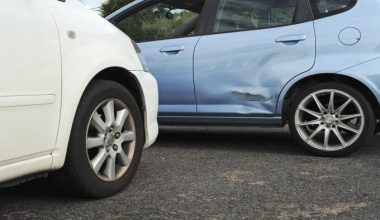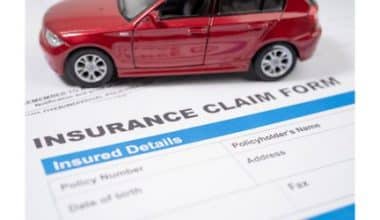Insurance increases by 49% after a car accident, or about $348 per year on average. The precise amount that a driver’s insurance increases after an accident is determined by a number of criteria, including the driver’s insurance company, the state, the extent of the damage, and who was at fault. Furthermore, drivers who have accident forgiveness will not see their rates increase after their first accident, albeit the specifics differ per insurance.
Why Do Insurance Rates Rise Following an Accident?
Car insurance rates are based on statistics, and the data shows that if you’ve already been in an accident, you’re more likely to be involved in another one. Although it may appear that way, a rate rise after a claim is not a form of punishment. Rather, your insurance company raises your rate to reflect the increased risk.
Although at-fault incidents are more likely to boost your premiums than non-fault accidents, any claim can have an impact on your premium, especially if you file many claims in quick succession. The good news is that your rate may return to baseline after a few years of no claims.
If your premium becomes unmanageable as a result of an accident, it may be beneficial to investigate your choices by getting free online insurance quotes. However, it is critical to be honest about your claims history when doing so. Many insurers will not order your driving record during the quoting process and will instead compute your estimated rate based on the information you provide. Failure to declare driving behavior may result in an artificially low premium, which will be modified after you agree to transfer car insurance companies.
What Effect Does a Car Accident Have on Insurance?
The property damage or harm that you cause to someone else is covered by the car liability insurance section of your policy. A claim against your liability insurance may result in a “surcharge,” which is the actual rate rise following a chargeable car accident.
The surcharge will begin when you renew your policy (an insurance company cannot charge you throughout the policy time). You can switch insurance companies, but the new one will look at your claims history and driving record, so it will be aware of the incident and adjust your cost appropriately.
Car Insurance Rate Increases When You Cause an Accident
We looked at average rates from ten major auto insurance providers for at-fault accidents that caused property damage or injury.
- State Farm had the lowest average rate spike (21%) for at-fault accidents resulting in solely property damage, while Geico had the largest (73%).
- The average rate increase for drivers who commit property damage is 40%, however USAA had the lowest total cost at $1,600 each year. It should be noted that USAA exclusively sells coverage to active and retired military personnel, as well as their immediate relatives.
- With an average annual cost of $3,103, Allstate was the most expensive for drivers who caused property damage in an accident.
Car Insurance Rates Increase Due to Property Damage in an Accident
| Company | Average annual rates for a good driver | Average annual rates after at-fault accidents with injuries | Average rate increase after an at-fault accident with injuries |
| USAA | $1,141 | $1,613 | 41% |
| State Farm | $1,402 | $1,713 | 22% |
| Erie | $1,419 | $1,898 | 34% |
| Travelers | $1,435 | $2,000 | 39% |
| Geico | $1,182 | $2,097 | 77% |
| Auto-Owners | $1,532 | $2,106 | 37% |
| Nationwide | $1,540 | $2,458 | 60% |
| Progressive | $1,892 | $2,975 | 57% |
| Farmers | $2,124 | $3,049 | 44% |
| Allstate | $2,022 | $3,133 | 55% |
Among the firms we looked at, car insurance rates are marginally higher after an at-fault accident involving injuries vs a property damage accident. We discovered:
- For drivers who caused an accident that resulted in injuries, average rate hikes varied from 22% (State Farm) to 77% (Geico).
- USAA had the lowest overall rate at $1,613 per year, despite a 41% average rise. State Farm had the lowest average rate behind USAA.
- Allstate was once again the most expensive, with an average annual rate of $3,133.
Car Insurance Rates Increase Due to an Injury in an Accident
| Company | Average annual rates for a good driver | Average annual rates after at-fault accident with injuries | Average rate increase after at-fault accident with injuries |
| USAA | $1,141 | $1,613 | 41% |
| State Farm | $1,402 | $1,713 | 22% |
| Erie | $1,419 | $1,898 | 34% |
| Travelers | $1,435 | $2,000 | 39% |
| Geico | $1,182 | $2,097 | 77% |
| Auto-Owners | $1,532 | $2,106 | 37% |
| Nationwide | $1,540 | $2,458 | 60% |
| Progressive | $1,892 | $2,975 | 57% |
| Farmers | $2,124 | $3,049 | 44% |
| Allstate | $2,022 | $3,133 | 55% |
These comparisons demonstrate how important it is to shop around for car insurance rates if you have been involved in an accident. The fee increase isn’t as significant as the total premium you’ll pay, so keep that in mind.
Car Insurance Rates Increase by State After an Accident
The average rise in vehicle insurance rates for drivers who have an accident varies by state. This is because state rules governing auto insurance rates differ across the country.
According to our findings:
- Wyoming drivers have the lowest average increase after both property damage and injury accidents (31%).
- North Carolina drivers face the largest average increase for a property damage accident (79%).
- California drivers face the largest rise (97% increase) for having an accident that results in injury.
Read Also: Best Car Insurance For High-risk Drivers: 2022 Comparison
| State | Average insurance rate increase after an at-fault accident with property damage | Average insurance rate increase after an at-fault accident with injuries |
| Alabama | 44% | 43% |
| Alaska | 46% | 53% |
| Arizona | 47% | 48% |
| Arkansas | 47% | 48% |
| California | 72% | 97% |
| Colorado | 35% | 33% |
| Connecticut | 51% | 52% |
| Delaware | 34% | 34% |
| Florida | 38% | 39% |
| Georgia | 47% | 47% |
| Hawaii | 37% | 37% |
| Idaho | 37% | 37% |
| Illinois | 49% | 49% |
| Indiana | 48% | 48% |
| Iowa | 45% | 47% |
| Kansas | 41% | 41% |
| Kentucky | 53% | 53% |
| Louisiana | 48% | 48% |
| Maine | 40% | 41% |
| Maryland | 52% | 52% |
| Massachusetts | 67% | 67% |
| Michigan | 45% | 45% |
| Minnesota | 41% | 42% |
| Mississippi | 46% | 47% |
| Missouri | 36% | 37% |
| Montana | 41% | 41% |
| Nebraska | 48% | 48% |
| Nevada | 43% | 44% |
| New Hampshire | 55% | 55% |
| New Jersey | 42% | 43% |
| New Mexico | 37% | 37% |
| New York | 40% | 40% |
| North Carolina | 79% | 90% |
| North Dakota | 39% | 39% |
| Ohio | 45% | 45% |
| Oklahoma | 44% | 44% |
| Oregon | 42% | 43% |
| Pennsylvania | 47% | 51% |
| Rhode Island | 55% | 45% |
| South Carolina | 39% | 39% |
| South Dakota | 42% | 42% |
| Tennessee | 44% | 45% |
| Texas | 54% | 54% |
| Utah | 44% | 44% |
| Vermont | 47% | 47% |
| Virginia | 45% | 45% |
| Washington | 36% | 37% |
| West Virginia | 41% | 41% |
| Wisconsin | 50% | 50% |
| Wyoming | 31% | 31% |
We averaged the rate increases among significant insurers in each state for drivers with liability coverage of $100,000 per person, $300,000 per accident, and $100,000 for property damage (100/300/100), as well as collision and comprehensive insurance. Quadrant Information Services is the source.
Accident Severity Variations and State Laws
A rate rise can be influenced by the overall severity of the car accident and the expense of an insurance claim. A modest fender bender in the parking lot is unlikely to have the same impact as a big accident. In some areas, your insurer cannot raise your rates if the claim is less than a particular financial amount.
In Massachusetts, for example, if you cause a car accident, you will not be charged a fee for accident claims under $1,000. Additionally, there is no premium in New York if there are no injuries and the total damage produced by the accident is less than $2,000. (However, if you have two or more accidents like this, you may be subject to higher rates.)
Can my car insurance rates rise if I wasn’t at fault in the accident?
Car insurance rates typically increase only after you commit a car accident that causes property damage or injuries to others. Here are some examples of car accidents that will not result in a rate hike:
- Your car was involved in a hit-and-run accident.
- When your car was damaged, it was legally parked.
- Your car was rear-ended by another vehicle, but you were not convicted of a moving traffic infraction as a result of the accident.
If you are involved in an accident, your car insurance provider may want proof that you were not at fault. Here are some documents you can collect:
- The police report on the accident
- A statement from the other driver’s insurance company admitting responsibility
- Another driver’s written statement attesting to culpability under penalty of perjury
- A legal document demonstrating that you were compensated for accident damage.
Furthermore, accident claims paid under comprehensive insurance do not usually result in a rate increase. These include animal collisions and harm caused by falling or flying objects (like gravel or road debris).
Comprehensive claims, on the other hand, are recorded in your claims history. Insurers generally believe that drivers with a claim history are more likely to file future claims, which can result in higher car insurance premiums.
How Long Will an Accident Have an Impact on My Car Insurance Rates?
The length of time an at-fault accident impacts your car insurance rates varies by insurance provider and state, but it is usually three to five years. For example, New York and Texas allow insurance companies to apply surcharges only for accidents that occurred within the last three years, whereas Massachusetts allows fees for five years.
Some states and insurers will reduce the amount of an insurance policy’s surcharge for each year you drive without an incident (such as another at-fault accident or a moving traffic violation).
Is it better to go through insurance or pay out of pocket?
If the cost of repairing your car is less than your deductible, or even slightly more, you should pay for the repairs yourself. For example, if the damage to your car costs $300 to repair and your deductible is $200, submitting a claim will save you $100.
Getting your car insurance rates reduced after an accident
Even if you do not qualify for accident forgiveness, you may be able to reduce your car insurance costs after a claim by doing the following steps:
Even if you do not qualify for accident forgiveness from your car insurance company, there may be alternatives to reduce your insurance premium after an accident. Speaking with your insurance agent is the greatest method to figure out how to save money. They may, for example, recommend savings for low-mileage drivers, students, or members of a specific occupation or group, as well as bundling your vehicle and house coverage with the same insurer. Regardless of your driving history, these discounts may be able to reduce your rate by up to 25%. This is because most discounts may be stacked together, optimizing your savings and bringing you closer to the lowest rates available.
If you’re not sure where to begin, the following strategies may help you save money on your insurance premium after an accident:
#1. Improve your credit:
Depending on where you live, your credit-based insurance score may be used to determine your car insurance quote. To enhance your credit status, stick to your spending budget, pay your obligations, and correct any anomalies on your credit report.
#2. Increase your deductible:
The larger your comprehensive and collision deductibles, the lower your rate. Before you boost your deductible, keep in mind that if you do, your out-of-pocket payments will be higher if you make a claim. Paying out of pocket may be possible for minor incidents. However, making sure your deductible is manageable will help you avoid financial problems in the event of a major accident.
#3. Look for discounts:
Most car insurance companies provide various discounts, such as good student discounts and multi-policy discounts. Many also provide usage-based telematics programs, which monitor your driving in real time and reward savings for safe driving habits such as adhering to posted speed limits and braking patterns. Progressive Snapshot, State Farm Drive Safe and Save, Allstate Drivewise, and Nationwide SmartRide are a few examples.
When your policy is up for renewal, it’s always a good idea to shop around to locate the best prices currently being given by different car insurance companies. It may be difficult to find a car insurance policy that provides the same coverage at the same price as before an at-fault accident, but you may also discover that other insurance companies offer various discounts and coverage options.
#4. Change your coverage options:
If you really must reduce your insurance premium, you may want to explore changing your coverage options. Although you should always consult with a certified agent before making any changes, reducing the amount of insurance you have may result in a reduced rate. You must still maintain your state’s minimum necessary coverage levels, and if you have a loan or lease, you may be obliged to retain full coverage on your vehicle, including comprehensive and collision coverage, but you may be able to reduce optional coverage selections.
#5. Consider a different vehicle:
Insurance companies rank each vehicle differently, and more expensive vehicles cost more to insure. This is determined by safety ratings, materials, repair costs, and a variety of other variables. If you need to reduce the cost of your car insurance policy, consider one of these low-cost solutions.
Frequently Asked Questions
How long does an accident stay on your record?
between three and five years
It all depends on the insurer and the nature of the accident. Accidents, on the other hand, will normally remain on your insurance record for three to five years.
When should you not file an insurance claim?
If the repair cost is less than your deductible, it’s probably not worth submitting a claim. Consider paying for the damage outside of your insurance company if your deductible is $1,000 and there is no property damage or the damage is less than the deductible.
- SUBROGATION IN INSURANCE: All You Need To Know
- Cheapest No Down Payment Car Insurance In 2022
- BEST CAR INSURANCE COMPANIES REVIEWS
- Best Car Insurance For Under 25: Costs and Discounts
- Car Accident Lawyer: Fees and How they Work






